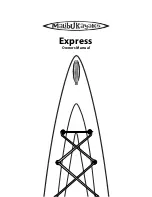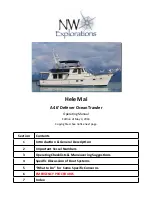
16
|
GREY LADY OPERATING MANUAL
NW Explorations
Section 4: Specific Discussion of Boat Systems
This section of the operating manual will discuss each of the boat’s systems in turn. The systems and major components
discussed are grouped and in order as follows:
• Main Engines & Sea Strainers
• Dinghy, Davit & Outboard Motor
• Fresh Water System;
• Electrical-AC, Electrical-DC, generator and Inverter;
• Heads and Holding Tanks;
• Heating System;
• Galley Equipment
• Navigation Equipment, Radios, and Radar.
Main Engines & Sea Strainers
The main engines on the boat are two Volvo Diesels D-4 IPS (Pod drive), each
producing a maximum of 300 horsepower. These extraordinarily-reliable, rugged
machines are the top-of-the-line and can be expected to give you trouble-free
economical cruising.
On engine start, no long warm-up is required! Three or four minutes is sufficient,
then load the engines by putting the transmissions in gear. Do not run them over
1200 RPM until the temperature gauges read at least 140° Fahrenheit. Do not
run the engines for long periods with the transmissions in neutral, with no load!
The engines require a regular, daily check, since once underway, you will
probably not check them while in use, tucked away as they are beneath
the cockpit floor.
Please perform this check each morning (when the engine
compartment is cool!):
CHECK THE OIL.
The oil level should be between the two marks on the dipstick.
The dipsticks are located on inboard side of each engine, and the stick “pulls
out” upward. Use a paper towel from the roll provided, wipe the stick, reinsert,
guiding the stick with the towel to keep from bending it, and take reading.
The distance between the two marks is about 1 quart. Add only enough oil to
bring it up above the “add” mark, say a quart, using the oil provided.
DO NOT OVERFILL
the crankcase (above the “full” mark), as these engines will
quickly waste excessive lubricant.
If oil is required often, check under the
engine carefully to be sure there is no oil leak, and if there is, have it corrected
promptly.
CHECK THE COOLANT LEVEL
.
The heat exchanger coolant tanks are located on
the forward end of each engine. The caps on the heat exchangers on the engines
themselves should NOT be opened if the engine is hot. In fact, unless an engine
appears to be overheating, or you see evidence in the engine room of a coolant
leak, it’s probably best to leave the coolant alone.
If coolant is needed, determine if there is any sign of a coolant leak under the
engine, and if there is, do not run the engine; if no leak, add coolant from the jug
of pre-mixed antifreeze/corrosion inhibitor/water supplied on the boat. To add
coolant, remove the cap on the engine heat exchanger by turning; you will have
to press the cap down and turn it past the second detent to get it off. Put a
finger into the tank; if it gets wet before it hits the baffle inside the tank, there is
enough coolant. Otherwise add coolant to cover the baffle.
Port engine coolant tank on
forward part of engine
Red starboard dipstick (center of picture)
Red port dipstick (center of picture)
















































